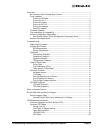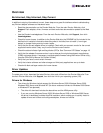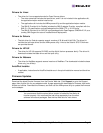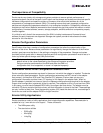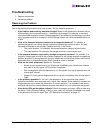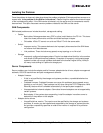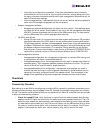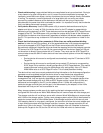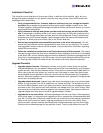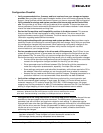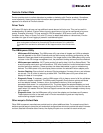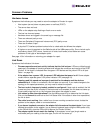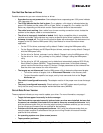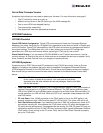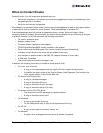
Troubleshooting and Maintenance Manual for LightPulse Adapters Page 7
• Check switch zoning. Large switched fabrics are complicated to set up and maintain. Zoning is
a key element of a good configuration, and it is one of the most complicated to manage. An
improperly zoned fabric can cause a variety of problems that are not always directly attributable
to zoning. For example, a small disturbance on a large fabric with no zoning can cause
connectivity problems because all the devices on the fabric will be trying to resolve the
disturbance at the same time which overloads the switch. It is important to verify that the device
that is not being discovered is properly zoned.
• Verify device discovery. Use the HBAnyware utility to examine devices discovered by the
adapter and driver. In nearly all OSs, the device driver for the FC adapter is responsible for
discovering all the devices in a SAN. These devices must then be assigned SCSI Target IDs and
mapped to the OS. The HBAnyware utility provides the unique ability to see all the devices on
the SAN that the device driver discovered, regardless of whether the devices where mapped to
the OS. This provides a way to determine if the device that is having problems is visible on the
SAN.
• Check that the Automap driver parameter is ON or there are valid persistent binding
entries. In order for the OS to present, all of the expected devices in its storage management
tool must be mapped to SCSI Target IDs so the OS can communicate with the devices.
As previously mentioned, the device driver performs the mapping function that assigns a remote
FC device to a SCSI Target ID so the OS can communicate with the device. Nearly all OSs do
not know how to directly communicate with a FC device. They must use the SCSI Target ID to
communicate across the SAN. Emulex device drivers have several options on how this mapping
is performed.
• Emulex device drivers can be configured to automatically map the FC devices to SCSI
Target IDs.
• Emulex device drivers can be configured to map certain FC devices to corresponding
SCSI Target IDs to maintain a known configuration of SCSI Target devices. This manual
mapping process is done using the HBAnyware utility and typically links a FC World
Wide Name value to a SCSI Target ID value. This is called persistent binding.
The device driver must have correct persistent binding information or the Automap configuration
parameter must be enabled to allow the device driver to map the devices automatically.
• Check storage configuration. When storage devices are presented in the OS storage
management tool, they are typically described as volumes or disks. The adapter device driver
maps discovered storage ports on a SAN as SCSI Targets and the Logical Units (LUNs) are
discovered and managed by the OS, not the adapter driver. If LUNs are configured on a
particular storage controller port and the port is not discovered by the adapter, all the LUNs
associated with that port will not be available for use.
Many storage systems provide security by requiring that each storage controller port be
configured with the host server World Wide Names that will communicate with that storage port.
The storage controller will not allow a server with unknown World Wide Names to communicate
with LUNs on the storage system. Further, some storage systems allow LUNs to be allocated to
particular servers based on World Wide Name. If the storage controller with this security and
LUN mapping feature is not properly configured, the controller will allow the server adapter port
to login and communicate with the storage controller, however, the storage controller will not
present any LUNs to the server. This means that the adapter driver will complete its discovery
and map the Targets to the OS, but the OS will not find LUNs with which to communicate.




